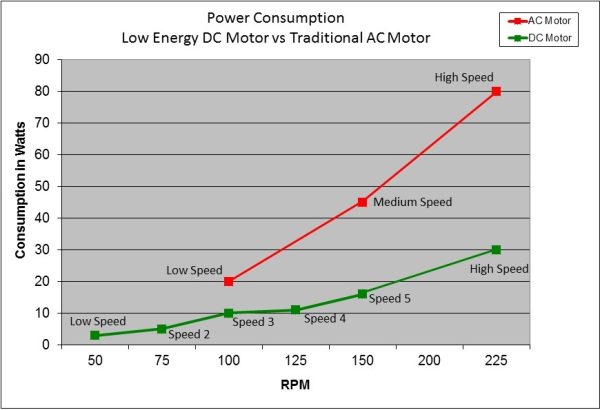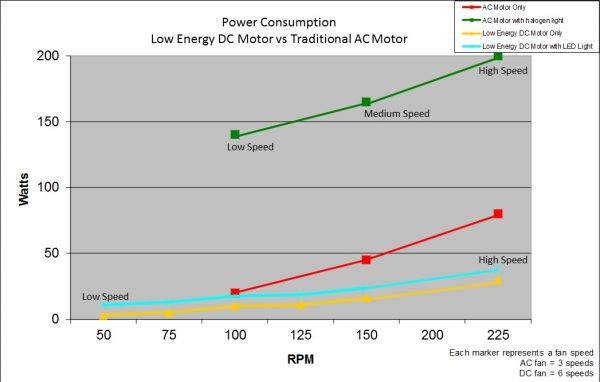Get A Massive Reduction over Air Conditioning Running Costs
You can slash your cooling energy use and costs by switching to a ceiling fan instead of air conditioning. The energy consumed by using a ceiling fan is approximately 95% less which is a massive reduction especially with rocketing electricity and energy costs. For temperate climates air-conditioning is simply not needed most of the year and apart from in a July heatwave when it is then having it is simply overkill. Since the costs of running it are so high especially in a heat-wave many retail outlets and restaurants that have AC installed don’t use it anyway, the later giving the excuse of not wanting to cool the food down.
Are Ceiling Fans as Effective as Air Conditioning?
In terms of cooling the ceiling fan cools in two ways:
- The Bernoulli “wind-chill” effect – The flow of air over the skin increases the flowrate due to the shape resulting in a reduction in air-pressure which causes evaporation from the skin that removes heat from the body. This can give a 3-4 °C reduction in temperature.
- Bring in cooler non-humid air from colder solid surfaces or outside via a window. In time this evaporation can lead to an increase in humidity which tempers the effect so if the room is small you will need to bring in a bleed of fresh air to compensate. If the air outside is cooler then opening the windows will enable not only this fresh cooler unhumid air to enter the room and the saturated hot air to leave making the room comfortable. The solid mass of the walls act as a heat sink and so will also cool the air as it moves around them until they heat up which may take a few days in a heat-wave. Opening windows at night and leaving the fans on will draw in the cool night air to cool the mass down so that it can work effectively during the day.
Ceiling Fan Installation Costs are 90% Lower
With a ceiling fan you only need to run a lighting duty wire to the fan to install it. The fan just screws into the ceiling which can be suspended – in which case a special hanger is used – or into a solid wooden cross-member and controlled by a remote. With AC you have to install the ugly unit on the wall and run the coolant pipes through to the chiller fan that is outside. You will also need to install ducting if you want to conceal the units.
Using Ceiling Fans with Existing Air Conditioning
A combination of ceiling fans with air conditioning can save a lot of energy and money since the air conditioning settings can be set at a higher temperature for the same effect. The difference is 3-4 degrees centigrade which will be a 30-60% reduction in energy use so the return on investment is compelling.
Energy Saving Motors
Traditionally ceiling fans have used AC (alternating current) motors that in a typical ceiling fan that moves 11,000 m3/h would consume 70 watts of power. Then 6-7 years ago came the DC (direct current) motors that reduced that to 35w. Then 2 years ago the Taiwanese (who lead the field globally in this technology) developed the ECM (Electronically Commutated Motor) which is also a DC fan but a further significant improvement and whose use has spread to most consumer appliances that use energy hungry motors such as fridges, freezers, air conditioning. What is an ECM motor comprise of? It has 3 parts:
- The Motor — this has no copper windings like a conventional motor but instead uses a rotating stator that is driven by magnetic fields with no brushes. Brushes wear out and waste energy in the form of heat whereas the brushless motor does not. The motor operates off DC voltage – and so is also called a DC motor – so the mains AC which is fed to the fan must first be converted to DC using an invertor . On startup it will actually oscillate backwards and forward before getting going as it aligns the magnetic fields to drive the motor. The same motor will usually operate on both 110 volts and 220 volts, depending how the 5 pin power plug is configured. Rarely, does this go bad. The most common failure is due to someone “dropping” the module while it is plugged into the motor and breaking the wires going into the motor.
- The ECM Microprocessor — this is at the heart of the motor and is its brains. It receives the programming information from the board and “translates” it so the motor produces the desired airflow rate. It is mounted on top the motor or can also be remotely mounted and stores the relationship between speed, torque, and airflow. It is programmed at the factory to match a given unit. Each module is specific to a model and they are not interchangeable.
- The Control board – This is where you can set the desired airflow for each application.
The biggest benefit from this improved control of the motor is a more efficient motor with more energy converted into air movement rather than heat. The power consumption is about half that of a traditional DC motor for a given amount of airflow. The other great thing about an ECM motor in general is that it maintains a set precise airflow rate regardless of changes in torque. Things like air temperature and pressure thus won’t affect the airflow rate should they changed. Should a change occur then the RPM of the motor will either ramp up or down to maintain the set airflow rate. This also gives great controllability to a DC fan and so they usually have 6 speeds compared to the 3 that an AC ceiling fan would have.
Charts of Ceiling Fan Energy Consumption
Below we present some graphs that show how the energy consumption compares between a low energy DC-motor ceiling fan compared with a traditional AC-motor ceiling fan. The DC ceiling fan has 6 speeds whereas the AC fan has 3 speeds but even in high speed the DC fan only uses 24 watts of electricity, whilst still achieving the same RPM and airflow as the AC fan.
The first graph shows the power consumption of the fan motor only.
Our Range of Low Energy Ceiling Fans
In our shop you can select the fans that are DC low energy. Here we list them too:


